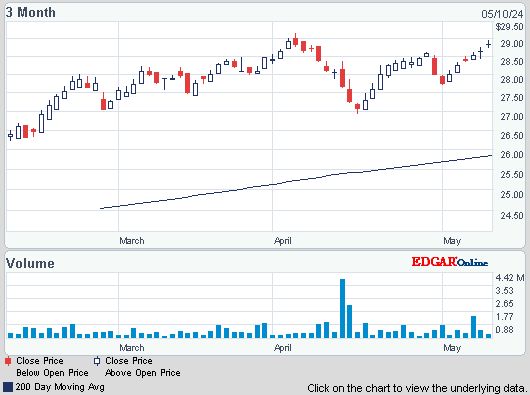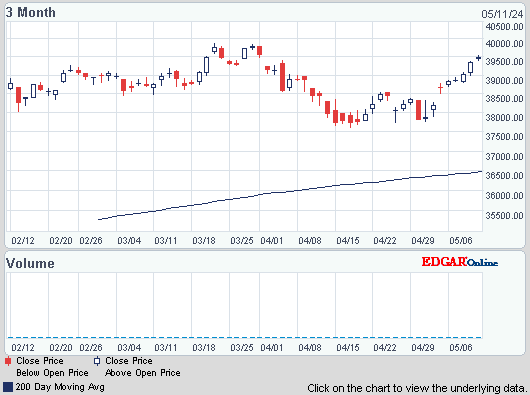Dow tumbled 200, decliners ahead of advancers a whopping 13-1 & NAZ dropped 41. The MLP index plunged 1+ (huge) to 427 (31 below its recent record high) & the REIT index lost 7+ to 268 (47 below its recent high). Junk bond funds fell 2-3% & Treasuries saw selling, bringing the yield on the 10 year Treasury to its highest in almost 2 years. Oil sank & gold went below 1300 (1700 is a distant memory).
AMJ (Alerian MLP Index tracking fund)


Photo: Yaoho
More Americans than expected filed claims for unemployment benefits last week, but not enough to signal a material shift from the recent pace of moderate job growth. Initial claims increased 18K to 354K, according to the Labor Dept. The forecast called for a rise to 340K. The 4-week moving average rose 2K to 348K, holding below the 350K mark that is usually associate with steady job gains. Despite the increase last week, claims remained in the middle of their range for this year. The report showed the number still receiving benefits under regular state programs after an initial week of aid fell 40K to 2.95M.
Jobless Claims in U.S. Climbed More Than Forecast Last Week

Photo: Yahoo
Home resales rose in May to the highest level in 3½ years & prices jumped, a sign the housing sector recovery is gathering steam & could give the economy a boost. The National Association of Realtors said that existing home sales advanced 4.2% to an annual rate of 5.18M, the highest level since Nov 2009 when a home-buyer tax credit was expiring. "Whatever inventory is coming onto the market, buyers are ready to snap it up," said Lawrence Yun, an economist at the NAR. The increase beat expectations for a rise to a 5M unit rate last month. In May, the median home sales price increased 15.4% from a year ago to $208K, the biggest year-over-year increase since 2005 & left prices at their highest level in 5 years. With prices rising, more sellers put their properties on the market, lifting the inventory of unsold homes on the market 3.3% from Apr to 2.2M. Still, the stock of homes for sale continues to be tight in the market. The May level of inventories represented just 5.1 months' supply, down from 5.2 in Apr. A 6 month supply is considered to be a healthy balance between supply & demand.
Sales of Existing U.S. Homes Rise More Than Forecast

Photo: Bloomberg
China's factories are faltering again, pointing to slowing growth & raising pressure on the country's central bank to relax policy even as it tries to contain an explosion of credit. HSBC said its "flash" index of Chinese manufacturing purchasing managers' sentiment fell to a 9-month low of 48.3 in Jun, as new export orders dropped sharply & production contracted for the first time in 8 months. The reading was much weaker than expected & reinforces concern that Q2 growth will slow from the 7.7% rate in Q1. There are forecasts that the rate of growth may even dip below 7% in H2, well below China's official 2013 target of 7.5%, given the new gov emphasis on reform rather than short-term stimulus to support the economy. The IMF last month cut its growth forecast for China to 7.75%, & raised concerns about a rapid expansion in credit, questioning the quality of investment & ability of borrowers to repay loans. There are worries that the expansion of credit is not translating into growth & is increasingly dominated by unregulated lenders such as trust companies, securities dealers & underground operators that make up the shadow banking system.
This is an ugly day in the markets & may be followed by a lot more selling. Dow has risen over 3K in a year, eye popping by any standard. But that rise was fueled more by advantages associated with low interest rates than mediocre economic data. The recovery from the recession 5 years ago has been the slowest in decades & now the economy is slowing further. Interest sensitive companies like MLPs & REITs will be hurt by higher interest rates because they are constantly borrowing more money to finance expansion. The bears are feeling a lot better today.
Dow Jones Industrials

AMJ (Alerian MLP Index tracking fund)
Treasury yields:
U.S. 3-month |
0.05% | |
U.S. 2-year |
0.32% | |
U.S. 10-year |
2.40% |
| CLV13.NYM | ....Crude Oil Oct 13 | ...95.80 | (2.6%) |
| GCM13.CMX | ...Gold Jun 13 | ......1,292.80 | (5.9%) |

Photo: Yaoho
More Americans than expected filed claims for unemployment benefits last week, but not enough to signal a material shift from the recent pace of moderate job growth. Initial claims increased 18K to 354K, according to the Labor Dept. The forecast called for a rise to 340K. The 4-week moving average rose 2K to 348K, holding below the 350K mark that is usually associate with steady job gains. Despite the increase last week, claims remained in the middle of their range for this year. The report showed the number still receiving benefits under regular state programs after an initial week of aid fell 40K to 2.95M.
Jobless Claims in U.S. Climbed More Than Forecast Last Week

Photo: Yahoo
Home resales rose in May to the highest level in 3½ years & prices jumped, a sign the housing sector recovery is gathering steam & could give the economy a boost. The National Association of Realtors said that existing home sales advanced 4.2% to an annual rate of 5.18M, the highest level since Nov 2009 when a home-buyer tax credit was expiring. "Whatever inventory is coming onto the market, buyers are ready to snap it up," said Lawrence Yun, an economist at the NAR. The increase beat expectations for a rise to a 5M unit rate last month. In May, the median home sales price increased 15.4% from a year ago to $208K, the biggest year-over-year increase since 2005 & left prices at their highest level in 5 years. With prices rising, more sellers put their properties on the market, lifting the inventory of unsold homes on the market 3.3% from Apr to 2.2M. Still, the stock of homes for sale continues to be tight in the market. The May level of inventories represented just 5.1 months' supply, down from 5.2 in Apr. A 6 month supply is considered to be a healthy balance between supply & demand.
Sales of Existing U.S. Homes Rise More Than Forecast

Photo: Bloomberg
China's factories are faltering again, pointing to slowing growth & raising pressure on the country's central bank to relax policy even as it tries to contain an explosion of credit. HSBC said its "flash" index of Chinese manufacturing purchasing managers' sentiment fell to a 9-month low of 48.3 in Jun, as new export orders dropped sharply & production contracted for the first time in 8 months. The reading was much weaker than expected & reinforces concern that Q2 growth will slow from the 7.7% rate in Q1. There are forecasts that the rate of growth may even dip below 7% in H2, well below China's official 2013 target of 7.5%, given the new gov emphasis on reform rather than short-term stimulus to support the economy. The IMF last month cut its growth forecast for China to 7.75%, & raised concerns about a rapid expansion in credit, questioning the quality of investment & ability of borrowers to repay loans. There are worries that the expansion of credit is not translating into growth & is increasingly dominated by unregulated lenders such as trust companies, securities dealers & underground operators that make up the shadow banking system.
This is an ugly day in the markets & may be followed by a lot more selling. Dow has risen over 3K in a year, eye popping by any standard. But that rise was fueled more by advantages associated with low interest rates than mediocre economic data. The recovery from the recession 5 years ago has been the slowest in decades & now the economy is slowing further. Interest sensitive companies like MLPs & REITs will be hurt by higher interest rates because they are constantly borrowing more money to finance expansion. The bears are feeling a lot better today.
Dow Jones Industrials










No comments:
Post a Comment